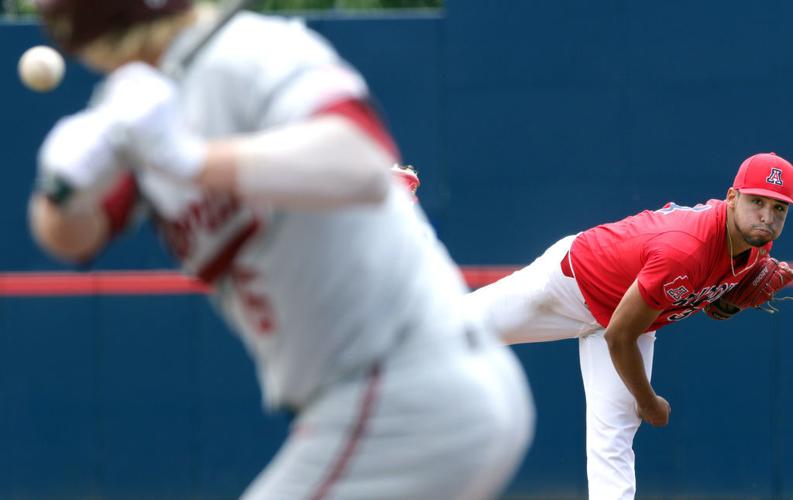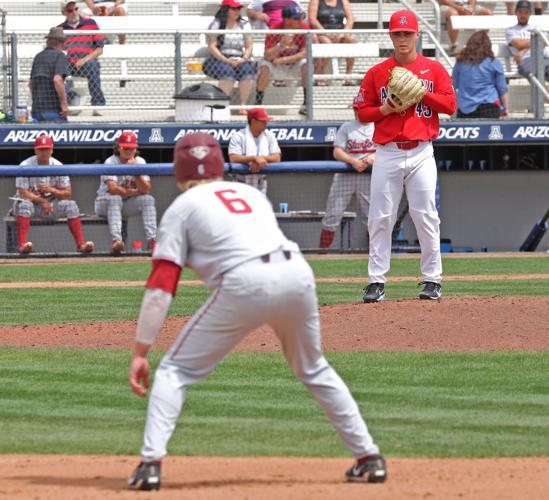Dave Lawn is moving about his “office,” the newly constructed home bullpen at Hi Corbett Field. The Arizona Wildcats pitching coach is showing a visitor what his charges must do to finish off batters — which just might be the key to finishing off the 2018 season.
First, Lawn points.
“Somewhere between the black and the batter’s box line,” he says. “That’s a ball, but they also get called. And if you can get a guy to reach …”
Then, Lawn demonstrates. He simulates an uncertain, off-balance swing — the sort of swing you want your pitchers to induce, especially with two strikes.
“I would say 98 percent of what we send in from the dugout we send in with the intention of getting a reaction,” Lawn says. “We want it to be close enough.”
Arizona’s pitchers did not execute those precise pitches often enough last weekend against Stanford. The result was a sweep for the third-ranked Cardinal, including two late-inning comebacks.
With a trip this weekend to Utah — which has swept Arizona each of the past two seasons, including four comebacks in the seventh inning or later — you can imagine what the focal point has been for the pitching staff entering the second half of Pac-12 play.
“When we’re trying to pitch to the edge,” Lawn said, “pitch to the edge.”
Arizona surrendered 13 two-strike hits to Stanford. In Lawn’s view, that’s three to five too many.
“If you’re just ordinary, it changes the game,” he said. “It changes the inning for the reliever if it happened to him. It changes the length you get out of (Cody) Deason or (Michael) Flynn (Arizona’s Friday and Saturday starters). It just changes everything.
“I looked at all 13 of them on film. There were some that were good pitches, and the guys got hits. There were some that were bad pitches, and they got outs. It just kind of reared its head. It was totally magnified in that inning.”
That inning was the top of the ninth in Saturday’s Game 2 against the Cardinal. The Wildcats had taken a 6-3 lead in the bottom of the eighth on freshman Jacob Blas’ three-run, inside-the-park homer. Closer Tylor Megill had been sitting for a while, but he pitched a 1-2-3 eighth. Arizona was three outs away from squaring the series.
Megill got ahead of Beau Branton 1-2 before surrendering a ground single up the middle. Megill got ahead of Tim Tawa 0-2 … before surrendering a double down the third-base line. Next batter? Same thing. On a 1-2 pitch, Nico Hoerner reached on an infield single to the right side.
By the time the inning was over, Stanford had five runs. The Cardinal prevailed 8-7, dropping the Wildcats’ record in one-run games to 3-9.
The previous night, Arizona led 2-0 entering the seventh. The Wildcats yielded eight runs over the final three frames.
“We need to be a little bit sharper,” UA coach Jay Johnson said. “The margin between winning and losing both Friday and Saturday was really small if we can make a couple more pitches in spots.”
The theme of finishing applies to innings as well. Stanford scored the tying and go-ahead runs Saturday on a two-out single The Cardinal batted .333 (13 of 39) with two outs in the series. Opponents had been hitting .187 with two outs against Arizona.
Asked what he told his staff this week after the disappointing Stanford series, Lawn said: “It’s not as bad as you think. You can’t let the fact that you had a really good team take it to you derail you from what’s reality.”
Although they have struggled in one-run games and had bullpen problems earlier in the season, the Wildcats have pitched well overall. Despite allowing 23 runs against the Cardinal, the Cats ranked third in the Pac-12 and 18th in the nation with a 3.22 ERA entering Thursday night. Megill had allowed three runs all season before being charged with five Saturday.
Arizona’s first-pitch and 1-1 strike rates were above 60 percent in the Stanford series — well within acceptable parameters, per Lawn. The pitchers just need to finish off batters and innings better.
“There’s been some good,” Johnson said. “There’s been some games that we feel like we let get away. I felt like for the majority of that series, the competitiveness of the team was good, was in place. We just didn’t make the pitches we needed to at the end.”
Stevenson out, Salazar in?
Senior center fielder Cal Stevenson (hand) will be held out of the Utah series and Monday’s game against Utah Valley in the hope that he can return next week against UCLA.
Stevenson got hit by a pitch in the right hand in the first inning against USC on April 15. He missed most of the rest of that game, as well as the next two vs. BYU and Stanford.
Stevenson returned Saturday night and started at DH. But the hand swelled up again, and he couldn’t play in Sunday’s finale.
“I give him a lot of credit,” Johnson said. “It’s a lot of toughness to get back in the saddle and have the at-bats that he had on Saturday. But his hand swelled up. We’ve gotta give it some time to calm down.”
Johnson said he’s “very hopeful” that junior catcher Cesar Salazar will be able to play Friday. Salazar had to leave Saturday’s game after being struck three times by foul pitches, including twice in the facemask. He did not play Sunday.
Inside pitch
- Deason (4-3, 2.20 ERA) and Flynn (5-2, 4.30) will start the first two games vs. Utah. Deason will face right-hander Tanner Thomas (2-2, 5.33). The rest of the starters are TBA.
- Utah (10-28, 4-11 Pac-12) ranked last in the conference in ERA (6.12) and opposing batting average (.301) entering Thursday night. The Utes have an 8.02 ERA in Pac-12 play.
- Arizona (23-15, 6-9) was 42nd in RPI through Wednesday. Stanford was No. 1. Oregon State, which lost two of three in Tucson earlier this month, was No. 7.





